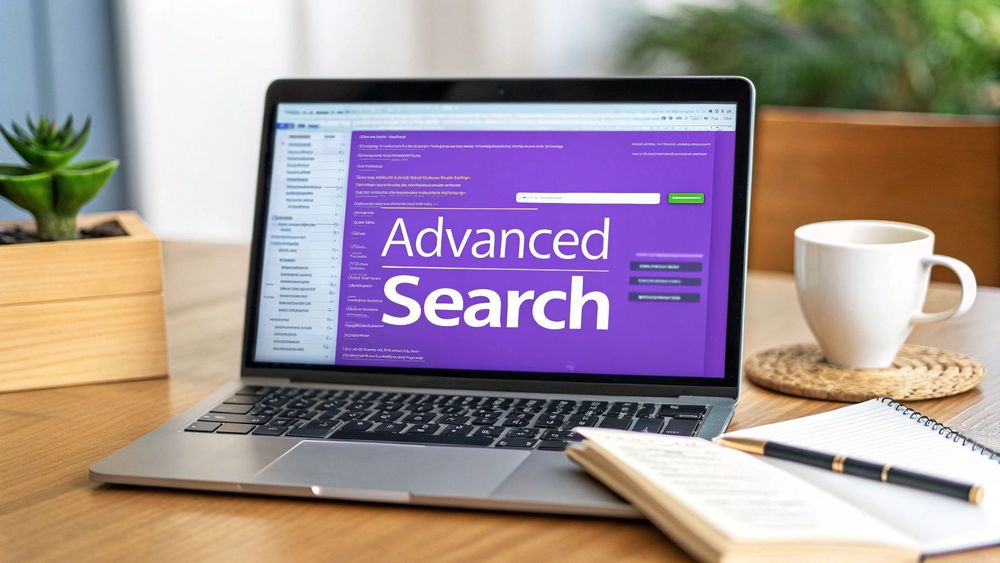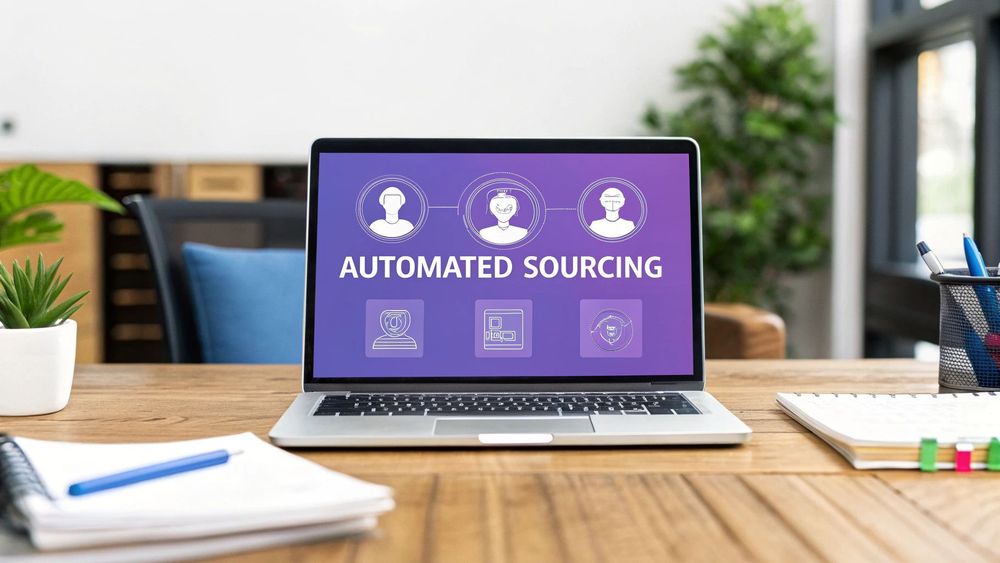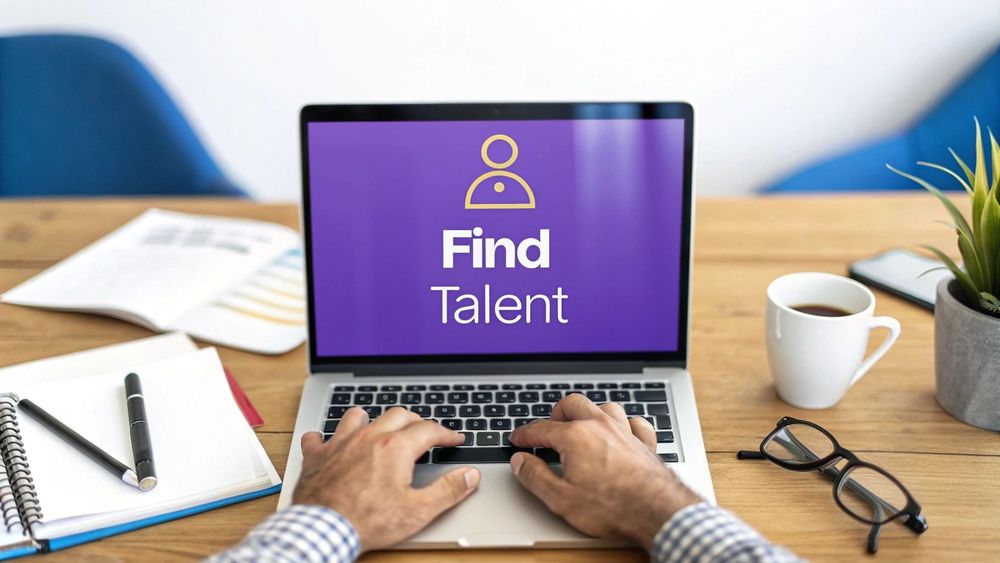Right now, AI in recruiting is brilliant at handling high-volume, repetitive tasks. Think resume screening and candidate sourcing—the stuff that can easily bog down a recruiter's day. But it still falls short when it comes to the nuanced, human judgment needed to truly assess things like cultural fit, soft skills, or a candidate’s long-term leadership potential.
The best way to think about it is as a powerful assistant that takes care of the grunt work, freeing you up to be a more strategic partner. It's not here to replace you; it's here to make you better at your job.
The Reality of AI in Recruiting Today
Let's cut through the hype. When people talk about "AI in recruiting," they're really talking about a powerful partnership between technology and human expertise. AI isn't a magic wand that solves every hiring headache. It's a specialized tool built to handle specific parts of the recruiting lifecycle with incredible speed and efficiency.
In short, it’s an amplifier for a recruiter's skills, not a substitute for them.
The real strength of today's AI is its ability to process and analyze massive amounts of data—far more than any human could. This is exactly why it shines at the top of the hiring funnel, where the sheer volume of applications can be overwhelming. But its capabilities start to thin out as candidates get closer to the finish line, where empathy, negotiation, and deep interpersonal understanding are absolutely essential.
This breakdown shows you where AI helps most and where humans still own the process.
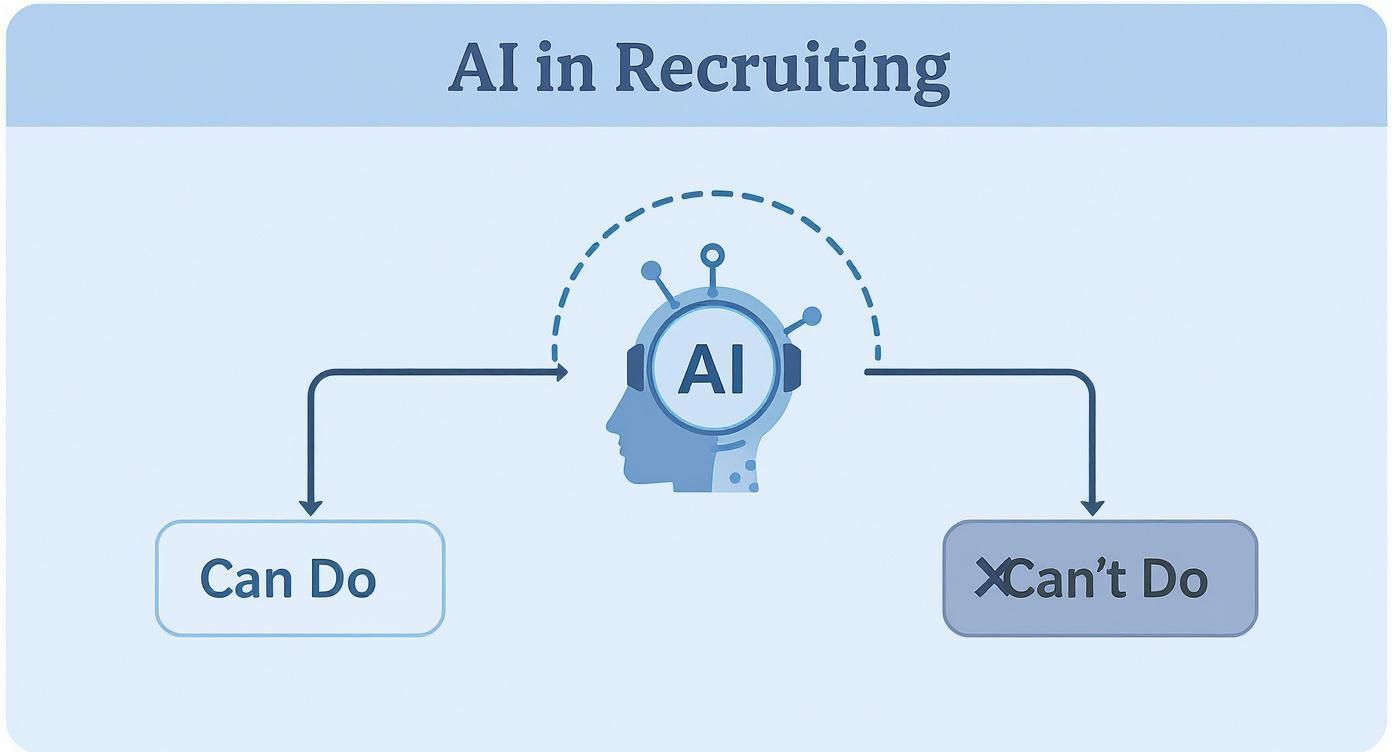
As you can see, AI's sweet spot is the data-driven, objective stuff. Humans are still mission-critical for the subjective, relationship-based decisions that lead to a great hire.
AI Capabilities in Recruiting at a Glance
To make it even clearer, let's break down what these systems are genuinely good at today versus where they still have a long way to go. This table gives you a quick, at-a-glance view of the current landscape.
| What AI Can Do Right Now | What AI Can't Do (Yet) |
|---|---|
| Screen thousands of resumes against job criteria in minutes | Accurately gauge a candidate's personality or humor |
| Source passive candidates from multiple online platforms | Understand a candidate's long-term career aspirations |
| Automate interview scheduling and reminders | Assess creativity or complex problem-solving skills |
| Analyze job descriptions for biased language | Build genuine rapport or negotiate a complex offer |
| Conduct initial screening with chatbots and assessments | Make the final, intuitive judgment on a hiring decision |
This distinction is key. Relying on AI for tasks in the right-hand column is a recipe for mismatched hires and a poor candidate experience. The magic happens when you let the tech handle the left column, giving you more time to focus on the human side of things.
AI Adoption and Its Challenges
The push to bring AI into the recruiting workflow is definitely picking up steam. As of 2025, about 43% of organizations worldwide are using AI for HR tasks, a significant jump from just 26% in 2024. This rapid growth shows just how valuable these tools are becoming.
But it's not all smooth sailing. The biggest hurdles are making sure these AI systems are free from bias and compliant with new regulations. Regulators are already classifying many recruitment AI systems as 'high-risk,' which means the stakes are getting higher.
If you're looking for a practical overview of how AI is being used in the wild, checking out a list of the best tools for recruiters can give you a real feel for what's possible today.
The goal isn’t to automate the human element out of hiring. It’s to automate the tedious work so recruiters can spend more time being human—building relationships, understanding motivations, and making truly informed decisions.
Ultimately, knowing what AI can and can't do is the first step to using it smartly. When you give AI the right jobs, you free up your most valuable resource—your time—to focus on the strategic work that only you can do.
Automating Sourcing and Screening with AI

This is where AI really starts to pull its weight, tackling the high-volume, often repetitive work at the top of the hiring funnel. For years, recruiters have been swimming in a sea of applications. Now, AI tools are finally smart enough to not just manage the deluge but to do it with a speed and precision that can save hundreds of hours.
We're way beyond basic keyword matching. Modern AI uses sophisticated semantic analysis to understand the context and relationships between different skills. For instance, if you're looking for a 'Data Visualization Specialist,' the AI can instantly flag top talent skilled in Tableau or Power BI, even if those specific tool names aren't explicitly listed on their profiles.
Finding Talent Beyond Job Boards
Proactive sourcing is where AI is a complete game-changer. The traditional method of waiting for people to apply is slow and limiting. AI allows you to scan professional networks, social media, and niche websites to uncover passive candidates—talented professionals who fit your ideal profile but aren't actively job hunting.
This isn't a futuristic concept; it's rapidly becoming the standard. By 2025, an estimated 81% of recruiters globally use AI to source passive candidates, a massive indicator of its central role in modern talent acquisition. This sourcing power is usually paired with automated resume screening, where AI evaluates candidate profiles with that same smart semantic analysis, connecting core skills to related tools and experiences. You can read more about these AI recruitment trends to see just how quickly the industry is shifting.
AI's ability to sift through thousands of profiles in minutes isn't about replacing recruiters. It’s about giving them a serious strategic advantage. It lets you build a rich pipeline of qualified talent before a role even opens up.
From Sourcing to Actionable Data
Finding great candidates is only half the battle. The real business value comes from turning that raw information into an organized, actionable database. Manually copying and pasting names, job titles, and contact info is not only painfully slow but also riddled with errors.
This is where a no-code tool like ProfileSpider becomes a recruiter's best friend, overcoming the challenge of manual data collection. An AI scraper like ProfileSpider simplifies the entire data extraction process into a single click, a stark contrast to complex coding or endless manual work.
- One-Click Profile Extraction: Instantly grab complete professional profiles from any website—LinkedIn, GitHub, company directories, you name it.
- AI-Powered Accuracy: The AI-powered engine accurately captures names, job titles, companies, locations, contact info, and social links without manual data entry.
- Smart Organization: Organize extracted profiles into custom lists and export them directly to your ATS or CRM.
This approach turns sourcing from a manual slog into an efficient, automated workflow. By automating the data collection, you free up your time to do what you do best: engaging with the high-potential candidates the AI just found for you. These AI-powered extraction tools feed directly into foundational technologies like modern applicant tracking systems (ATS), connecting the entire hiring process seamlessly.
Where Human Judgment Still Wins, Hands Down
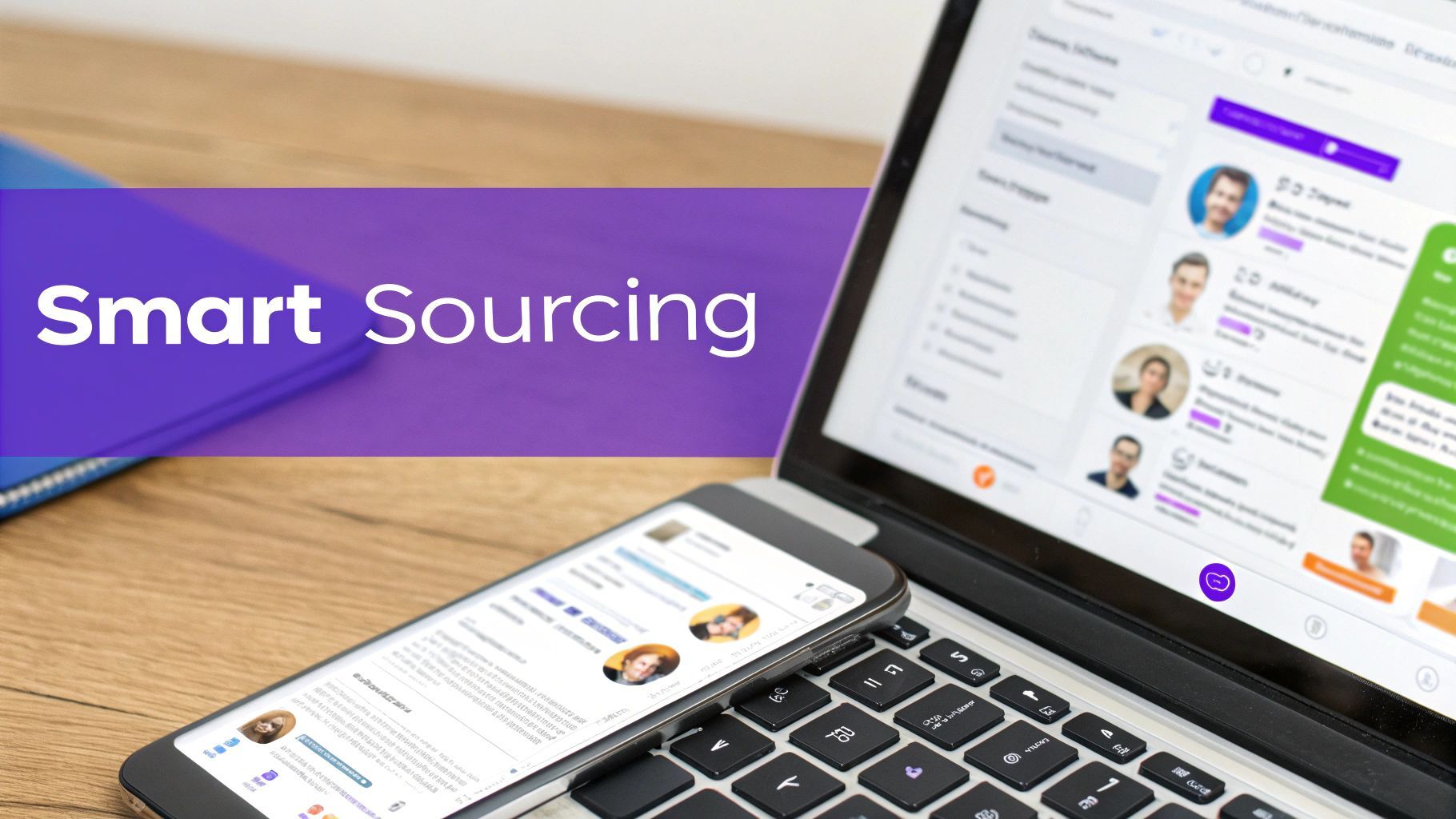
After seeing what AI can do with data, it’s just as important to talk about what it can't do. AI is a powerhouse for screening hard skills with surgical precision, but it hits a wall when it comes to the nuanced, unquantifiable qualities that separate a good hire from a great one.
This is where your intuition, experience, and ability to connect with another human being are completely non-negotiable. At the end of the day, recruiting is about people, and the most critical hiring decisions hinge on things you’ll never find in a resume.
The Things an Algorithm Can't See: Soft Skills
Let's be honest: AI is terrible at assessing soft skills. Things like creativity, emotional intelligence, and true leadership potential are next to impossible for an algorithm to measure because they don’t show up as keywords. They show up in conversation, in body language, and in the way someone tells a story.
An AI can tell you a candidate has "leadership experience" listed on their resume. What it can't tell you is if they have the grit to rally a team through a tough quarter or the empathy to manage a difficult conversation.
These are the human-centric skills that form the bedrock of any successful team. If you lean too heavily on AI to find them, you risk building a team that looks flawless on paper but falls apart under pressure.
The Gut Feeling of Cultural Fit
The biggest blind spot for AI? Gauging cultural fit. Every company has a unique vibe—an unwritten set of rules, a specific communication style, a shared sense of humor. It's a delicate ecosystem that a person can feel out in minutes, but an algorithm can't even begin to compute.
AI can’t sit in a room and know if a candidate's personality will click with the rest of the team. It can't tell you if their work style will complement your company's fast-paced, collaborative culture. That’s the magic of human connection—knowing when someone doesn’t just fill a role, but truly belongs.
The Hidden Trap of Algorithmic Bias
Finally, we have to talk about the very real risk of algorithmic bias. Think of an AI trained on your company's historical hiring data. If that data reflects decades of unconscious biases—hiring from the same schools, preferring certain backgrounds—the AI will learn those biases as rules.
Before you know it, the algorithm is systematically screening out diverse, high-potential candidates simply because they don't fit a pattern from the past. It’s a surefire way to reinforce the exact echo chamber you’re trying to break.
This is precisely why human oversight is irreplaceable. A good recruiter knows how to question the data, challenge the patterns, and give every candidate a fair shot based on their potential, not their pedigree. Knowing when to trust the machine and when to trust your gut—that's the art of recruiting with AI.
Streamlining the First Interview
After AI helps you track down and sort through a promising group of candidates, its next big win is completely overhauling the initial interview. We all know this first touchpoint is usually a high-volume, time-sucking step. Its main job is just to confirm someone meets the basic qualifications and is genuinely interested. This is exactly the kind of repetitive work AI was built for.
Think about it: what if you could replace dozens of 15-minute screening calls with a single, automated process? AI platforms can run text or video interviews with every single qualified applicant. They ask the same questions every time, which keeps the playing field level for everyone.
But this isn't just about clawing back hours in your day. It’s about getting better, more organized data right from the get-go. The tech does more than just type out what candidates say; it analyzes their responses for key skills, how clearly they communicate, and whether they seem like a good match for what the role actually demands.
Turning Raw Answers into Usable Insights
Here’s where it gets really powerful. Instead of you having to listen to hours of recordings or scroll through endless transcripts, the AI pulls it all together for you. It hands you a summary with data-backed insights, making it easy to spot the candidates who deserve a real, human conversation.
The business value is clear: massive time savings. One randomized trial found that when recruiters used AI for the first screening interview, they ended up conducting 44% fewer human interviews to fill a role. That's because the AI does a much better job of filtering people out early on, so the candidates who make it to the next round are far more likely to be a good fit. You can dig deeper into how AI is affecting hiring transparency at weforum.org.
Letting AI handle the first wave of interviews isn't about letting a robot make the hiring decision. It’s just a smart filter. It makes sure the time you spend in live interviews is with a pre-vetted, high-quality group of people.
What This Means for Recruiters
This completely changes the recruiter's role in the interview process. You’re no longer stuck in the weeds, making the same repetitive screening calls over and over again. Instead, you can pour your energy into what actually matters: connecting with the top contenders.
This frees you up to focus on the distinctly human stuff that AI can’t touch—like figuring out if someone is a good cultural fit, understanding their long-term career goals, and building a genuine connection.
Ultimately, using AI for initial interviews is a perfect snapshot of what AI in recruiting can and can’t do right now. It’s brilliant at handling the scalable, data-heavy screening with incredible speed. But it can’t replace the nuanced, relationship-driven conversations that lead to a fantastic hire. It simply gives you the power to be more strategic and efficient, which leads to better hires down the line.
Navigating the Ethical and Compliance Risks
Jumping into AI for recruiting isn't just a tech upgrade; it's a major responsibility. As much as these tools can help, they also open up a minefield of risks around bias, privacy, and legal headaches. Getting this right means you need to understand these challenges from the get-go and have a solid plan to tackle them.
One of the biggest hurdles is the infamous "black box" problem. A lot of AI tools make decisions, but good luck figuring out how they made them. If your fancy new AI model keeps rejecting candidates from a specific background and you can't explain why, you’re not just dealing with an ethical mess—you’re walking straight into a legal nightmare.
This ties directly into the danger of algorithmic bias. Think about it: if an AI is trained on your company's historical hiring data, and that data reflects years of unconscious bias, the AI will learn those same bad habits. It won't just copy them; it'll often amplify them, turning subtle biases into systemic discrimination. It's the exact opposite of what modern hiring is supposed to achieve.
Data Privacy and Legal Compliance
Beyond bias, there’s the huge issue of data privacy. With regulations like GDPR in full swing, there are iron-clad rules about how personal data is handled. The moment you use an AI tool that sends candidate info to some third-party server, you've just added another risky, complicated layer to your compliance process.
You have to know where that data is going, who's looking at it, and how it's being protected. For recruiters sourcing profiles online, this isn't optional—it's essential. If you’re not crystal clear on the rules, it’s worth reading up on the legality of website scraping for recruiting to make sure you’re on the right side of the law.
An Evaluation Checklist for AI Recruiting Tools
Choosing the right AI tool requires more than just a feature comparison. You need to dig deep and ask some tough questions to make sure any vendor you work with is serious about ethics and compliance. This is about accountability, not just cool tech.
Before you sign on the dotted line, run every potential vendor through this checklist.
AI Tool Evaluation Checklist
| Evaluation Area | Key Questions to Ask the Vendor |
|---|---|
| Data & Training | Where did you get the data to train your model? How do you ensure it’s diverse and free from bias? |
| Bias Audits | Do you regularly audit your algorithms for bias? Can we see the results of those audits? |
| Transparency | Can you actually explain how your AI makes a recommendation? Is the logic behind a decision traceable? |
| Data Privacy | Where is our candidate data stored? Who has access? How do you ensure GDPR compliance? |
| User Control | Do we own and control our data completely? What’s the process for deleting it if we need to? |
This is where a privacy-first approach really shines.
ProfileSpider overcomes these challenges by storing all extracted profile data locally in your browser using IndexedDB. This simple design choice means you maintain complete control and ownership of your data. No data is ever sent to an external server without your consent, which eliminates one of the biggest GDPR compliance headaches for recruiters today and gives you total privacy.
Building the Future Human and AI Partnership
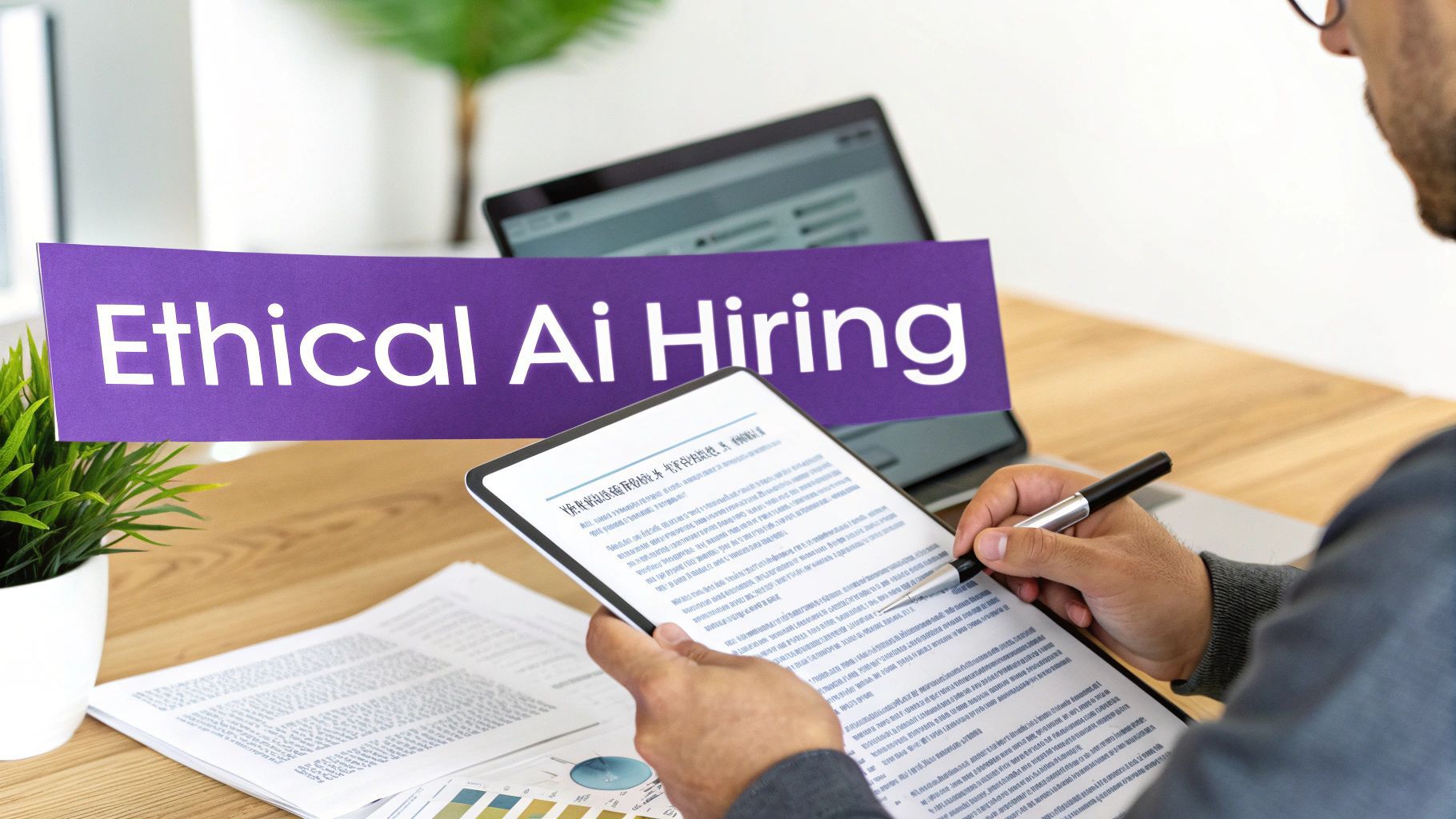
The future of recruiting isn’t about humans versus machines. Not even close. It’s about forging a powerful partnership where each side plays to its strengths.
Let’s be clear: AI is an incredible tool for chewing through data and automating the grunt work that bogs us down. But it can’t replicate the intuition, empathy, and strategic thinking that define great recruiting. That's where we come in.
This new dynamic creates what you might call the "augmented recruiter"—a sharp, strategic pro who lets AI handle the tedious stuff. By offloading the tasks that drain your time and energy, you’re free to focus on what actually moves the needle: building real relationships with candidates, navigating tricky negotiations, and making sure every person has a world-class experience.
It’s a fundamental shift. You stop being a tactical seat-filler and start becoming a strategic talent advisor.
Becoming an Augmented Recruiter
Jumping into this partnership doesn’t mean you have to blow up your entire workflow overnight. It’s all about making smart, small changes that save you time and boost your impact. Instead of drowning in admin, you can spend your days connecting with incredible people and making better, more informed hiring decisions.
A great place to start? Find the single biggest time-waster in your day and throw an AI tool at it.
For instance, if you still manually scrape professional networks to build candidate lists, you're losing hours that could be spent engaging talent. A modern, no-code tool like ProfileSpider automates that whole process into a single click, giving you back your time.
"Great tech won’t fix bad recruiting—it’ll just help you suck faster." This quote is a powerful gut check. AI is an amplifier, plain and simple. Your strategy and human touch are what drive success; the tech just helps you get there faster.
Actionable Steps for Adopting AI
Ready to give it a shot? Here are a few practical steps to start building your own human-AI partnership today:
- Identify Your Biggest Pain Point: What's the one task that makes you want to pull your hair out? Is it scheduling interviews? Sourcing candidates? Screening resumes? Pinpoint it.
- Start Small with One Tool: Don’t try to boil the ocean. Pick a single, easy-to-use tool that solves that specific problem. Get comfortable with it before you add anything else.
- Always Keep a Human in the Loop: Use AI to surface candidates and analyze data, but never let it make the final call. The hiring decision is, and always should be, human.
When you start seeing AI as an indispensable partner instead of a threat, your entire job changes for the better. You’ll be more strategic, more efficient, and ultimately, more successful in the critical mission of finding and hiring top talent.
Got Questions About AI in Recruiting?
As AI starts showing up more in our daily work, it's natural for recruiters to have some real-world questions about what it all means. Here are some straightforward answers to the things we hear most often.
Can AI Completely Replace Human Recruiters?
Not a chance. Think of AI as an incredibly powerful assistant, not a replacement.
It’s brilliant at the heavy-lifting, data-driven tasks like sourcing candidates and doing initial resume screens. But it can’t do what we do. AI can't read a room, gauge genuine cultural fit, build trust with a nervous candidate, or negotiate a complex offer. The future isn't about replacement; it’s a partnership. Technology handles the repetitive stuff, freeing you up to focus on the human-to-human strategy that actually closes candidates.
How Can I Avoid Bias When Using AI in Hiring?
This is a big one, and it's something to take seriously. The key is to stay in control and demand transparency.
Start by picking AI vendors who are open about how their algorithms work and what data they're built on. Ask them directly if they perform regular bias audits on their systems. But most importantly, never let the AI have the final say. Use it as a tool to surface a wider, more diverse pool of candidates, but always make sure a diverse team of actual people is making the final hiring decisions. That human gut check is your best defense against bias.
What Is the Best First Step to Implement AI?
Don't try to boil the ocean. The best way to start is to find your single biggest time-waster and target it.
Is it spending hours manually digging through LinkedIn profiles? Or is it sifting through hundreds of applications just to find a handful of qualified people? Pinpoint that one bottleneck, then find a tool that solves that specific problem.
For example, using a simple one-click tool like ProfileSpider to build targeted candidate lists can instantly give you hours back in your week. It solves the problem of manual data collection without any coding, allowing you to focus on engaging the talent you've found. If you're curious about how tools like this work, you can find a lot more answers on our comprehensive FAQ page. Start small, prove the value, and then build from there.


